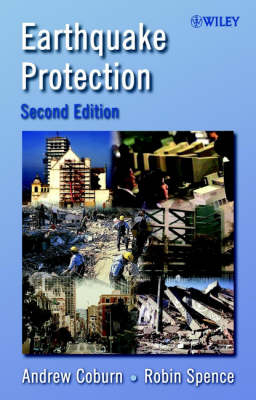
Earthquake Protection
John Wiley & Sons Ltd (Verlag)
978-0-471-49614-4 (ISBN)
- Titel ist leider vergriffen;
keine Neuauflage - Artikel merken
Since the publication of the successful first edition of Earthquake Protection there have been 110 lethal earthquakes, killing 130 000 people; there have also been significant developments in the field of earthquake risk management, particularly in the modelling and analysis of risk for insurance and financial services. Furthermore, major earthquake disasters, such as the 1994 Northridge earthquake in California, the 1995 Kobe earthquake in Japan and the 1999 Kocaeli earthquake in Turkey have occurred. The experience and knowledge gained through these events have improved our understanding of how to manage, mitigate and work towards the prevention of similar catastrophes. The 1990s were in fact the costliest decade on record in terms of disaster management due to such seismic events, placing unprecedented pressure on the insurance industry in particular, and changing its view of earthquake protection. Significantly revised and updated, this second edition continues to provide a comprehensive overview of how to reduce the impact of earthquakes on people and property, and implement best practice in managing the consequences of such disasters.
It also includes significant coverage of the techniques of modelling earthquake catastrophe. Each chapter deals with a separate aspect of protection, and covers a wide range of economic and social conditions, drawing on the authors' considerable personal experience and with reference to real life examples. Key features include: Recent event coverage Modern developments in the theory and practice of planning and engineering loss estimation techniques, along with new engineering techniques such as microzonation and hazard--mapping Historic buildings experience An entirely new chapter on 'Earthquakes and Finance' This valuable book provides essential reading for earthquake and structural engineers and geoscientists, as well as insurers and loss prevention specialists, risk managers and assessors involved in managing earthquake risk, urban and regional planners, and emergency management agencies.
Andrew Coburn is an executive of Risk Management Solutions, Inc., the world's leading insurance risk management and catastrophe modeling company, working with insurance clients to assist with the management of earthquake risk. Dr. Coburn has many years of international experience of earthquake risk analysis and catastrophe modeling. He originally completed his PhD on earthquake risk at Cambridge University in the 1980s under the supervision of Dr. Robin Spence and has studied many catastrophes and developed techniques for their analysis, modeling and quantification. For over 20 years, he has participated in the study of catastrophe events including 15 field damage surveys, ranging from the Italian earthquake in 1980 to the Gujarat earthquake in India in 2001. His research work has included research into human casualties in catastrophes, including Visiting Fellowships at Hokkaido University in Japan, Virginia Polytechnic Institute in Washington, DC, USA and University of Naples, Italy. Robin Spence is a structural engineer and Reader in Architectural Engineering in the Department of Architecture at Cambridge University. He has been active in the field of earthquake risk mitigation for over 20 years. During that time he has taken part in many field missions, and was one of the founders of EEFIT, the earthquake engineering team in 1983. He has also directed numerous research projects on earthquake vulnerability assessment, loss estimation and disaster mitigation, and is the author of many papers, reports and manuals on these subjects. He has frequently been a consultant to international agencies, national governments and insurance companies on the assessment and mitigation of earthquake and volcanic hazards. After obtaining his PhD on the analysis of reinforced concrete structures, Dr. Spence has been with the Department of Architecture at Cambridge University since 1975, and has been a Director and Joint Director of the Martin Centre since 1985. He has been a Visiting Professor at MIT and UCLA, at the University of Naples and at Macquarie University in Sydney. He is currently Director of the Cambridge University Centre for Risk in the Built Environment. He is also a Director of Cambridge Architectural Research Ltd, and a Fellow of Magdalene College, Cambridge.
About the Authors; Foreword; Acknowledgements; 1. Earthquakes, Disasters and Protection; 1.1 Earthquake Protection: Past Failure and Present Opportunity; 1.2 Earthquake Disasters; 1.3 Earthquakes; 1.4 Earthquake Protection; 1.5 Organisation of the Book; Further Reading; 2. The Costs of Earthquakes; 2.1 The Costs of Earthquakes in the Last Century; 2.2 Who Pays?; 2.3 The Private Building Owner; 2.4 The Insurance Industry; 2.5 The Public Sector; 2.6 Interrelated Risk; Further Reading; 3. Preparedness for Earthquakes; 3.1 Earthquake Prediction; 3.2 Long - term Prediction (Years); 3.3 Short - term Prediction (Days/Hours); 3.4 Instantaneous Warning (Seconds); 3.5 Practicalities of Prediction and Evacuation; 3.6 Getting the General Public Prepared; Further Reading; 4. The Earthquake Emergency; 4.1 Emergency Management; 4.2 Search and Rescue; 4.3 Search and Rescue Techniques; 4.4 Medical Aspects of Earthquake Disaster; 4.5 Follow - on Disasters; 4.6 Shelter, Food and Essential Services; 4.7 Re - establishing Public Confidence; Further Reading; 5. Recovering from Earthquakes; 5.1 Opportunities and Challenges; 5.2 Sectoral Recovery Plan; 5.3 Repairing Economic Damage; 5.4 Physical Reconstruction; 5.5 Housing and Shelter Policy; 5.6 Reconstruction and the Construction Industry; 5.7 Turning Reconstruction into Future Protection; Further Reading; 6. Strategies for Earthquake Protection; 6.1 Creating a Safe Society; 6.2 Personal Risk Management; 6.3 Corporate Risk Management; 6.4 Urban Risk Management; 6.5 National Risk Management; 6.6 International Aid and Development Organisations; Further Reading; 7. Site Selection and Seismic Hazard Assessment; 7.1 Choice of Siting; 7.2 Site - related Earthquake Hazards; 7.3 Estimating Ground Motion Hazard; 7.4 Effect of Site Conditions on Seismic Hazard; 7.5 Microzoning; 7.6 Mapping of Insurance Risks; Further Reading; 8. Improving Earthquake Resistance of Buildings; 8.1 Strong and Weak Building Types; 8.2 Building Response to Earthquakes; 8.3 How Buildings Resist Earthquakes; 8.4 Structural Form and Earthquake Resistance; 8.5 Choice of Structural Materials; 8.6 Codes of Practice for Engineered Buildings; 8.7 Improving the Resistance of Non - engineered Buildings; 8.8 Strengthening Existing Buildings; 8.9 Repair and Strengthening of Historical Buildings; Further Reading; 9. Earthquake Risk Modelling; 9.1 Loss Estimation; 9.2 Definition of Terms; 9.3 Vulnerability Assessment; 9.4 The PSI Scale of Earthquake Ground Motion; 9.5 The HAZUS Methodology; 9.6 Human Casualty Estimation; 9.7 Other Losses; 9.8 Applications of Loss Estimation; 9.9 Uncertainty in Loss Estimation; Further Reading; 10. Risk Mitigation in Action; 10.1 Introduction; 10.2 Improving Standards of Construction for New Buildings; 10.3 Strengthening Existing Buildings and Infrastructure; 10.4 Upgrading Rural Construction: Building for Safety; 10.5 Evaluating Alternative Protection Strategies; 10.6 Evaluation of Alternative Strategies: Some Examples; 10.7 Social and Public Policy Aspects of Earthquake Protection Strategies; 10.8 The Way Ahead; Bibliography; Index.
| Erscheint lt. Verlag | 6.9.2002 |
|---|---|
| Zusatzinfo | Illustrations, maps (some col.) |
| Verlagsort | Chichester |
| Sprache | englisch |
| Maße | 158 x 236 mm |
| Gewicht | 752 g |
| Themenwelt | Naturwissenschaften ► Geowissenschaften ► Geologie |
| Technik ► Bauwesen | |
| Betriebswirtschaft / Management ► Spezielle Betriebswirtschaftslehre ► Versicherungsbetriebslehre | |
| Wirtschaft ► Betriebswirtschaft / Management ► Unternehmensführung / Management | |
| ISBN-10 | 0-471-49614-6 / 0471496146 |
| ISBN-13 | 978-0-471-49614-4 / 9780471496144 |
| Zustand | Neuware |
| Haben Sie eine Frage zum Produkt? |
aus dem Bereich


